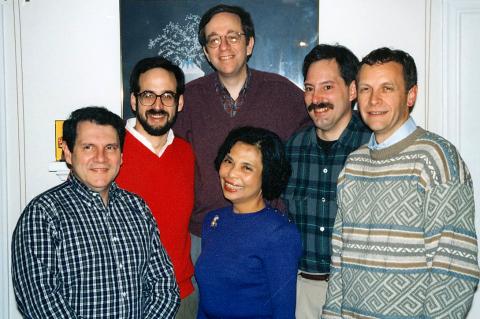The Skinny on Pemphigus
Yancey Traces Decades of Skin Biology Advances

The word pemphigus, from its sound alone, was never going to denote something lovely, like the words Cleopatra or Cassiopeia.
A group of rare, autoimmune intraepidermal blistering diseases that affect skin and mucous membranes, pemphigus is nevertheless a lens through which investigators have learned much about the biology of human skin.
In a recent Contemporary Clinical Medicine: Great Teachers talk, Dr. Kim Yancey, professor and chair of the department of dermatology at the University of Texas Southwestern Medical Center in Dallas, traced decades of research that deepened understanding of skin biology that began since he first entered the field of dermatology in 1978. His eventual membership in NCI’s Dermatology Branch, headed by Dr. Steve Katz, helped launch not only Yancey’s career, but also the careers of a generation of notable skin biologists.
Pemphigus affects the epidermis, the oral mucosa, throat, the esophagus and other stratified squamous epithelia.
“It is a disease mediated by autoantibodies that bind to epithelial cells and cause loss of cell-cell adhesion, or acantholysis,” said Yancey, speaking by videocast from Texas. “It may be fatal, even today.”
The disease comes in two major forms—pemphigus vulgaris, the most common form, which affects about 95 people per million annually worldwide, and pemphigus foliaceus, a more superficial version, which affects about 10 people per million each year, globally.
“In early pemphigus vulgaris, the disease is almost exclusively mucosal, mostly oral,” said Yancey. Lesions can appear inside the mouth and on the tongue. Skin lesions develop later, often on the upper part of the body—the scalp, face, neck and upper trunk.
“The loss of this much epithelium can compromise the barrier of skin, leading to infections,” Yancey noted.
Skin fragility is another feature, along with pain that can be severe. “I’ve had patients tell me it’s like the worst sunburn they ever had,” said Yancey.
Histologically, pemphigus vulgaris is quite distinctive, he noted. In pemphigus vulgaris, blisters form in epithelia just above the basal cell layer; in pemphigus foliaceus, blisters form superficially in the granular cell layer of the epidermis. Immunopathology studies show in situ deposits of autoantibodies on the surface of epithelial cells and circulating autoantibodies that react with the surface of normal stratified squamous epithelia.
In pemphigus foliaceus, patients develop “puff pastry” scale crusts that accumulate across the surface of lesions. “The disease can be widespread and severe,” noted Yancey, “and skin pain and secondary infection can occur,” even though blisters are more superficial than those in pemphigus vulgaris.

“It has always amazed me that an injury to stratified squamous epithelium that is so superficial, in a tissue that only has the thickness of several sheets of notebook paper, can elicit a disease that is so severe and potentially life-threatening,” Yancey said.
Over the past 60 years, investigators have learned an extraordinary amount about pemphigus pathophysiology, he recounted. It wasn’t until the late 1940s and early 1950s that pemphigus was distinguished from pemphigoid, a group of subepidermal autoimmune blistering diseases. The 1960s brought advances through light and immunofluorescence microscopy. In the mid-1980s, animal models were developed and pemphigus autoantigens (i.e., what patient autoantibodies were targeting in skin and mucosa) were first identified.
“This taught us not only about pemphigus, but epithelial biology as well,” Yancey said.
Treatment changed, too. Corticosteroids were an early therapy. But high doses of prednisone over time “often proved as detrimental to patients as the disease itself,” said Yancey. By the 1980s, it was recognized that steroid therapy put some patients at risk of death.
A paper in the New England Journal of Medicine in 1982, involving studies of mice, turned the field’s attention to autoantibodies in pemphigus, Yancey said. “This set the stage for a number of questions about those autoantibodies. What did they bind? Did all autoantibodies bind the same autoantigen? What role do these autoantigens play in skin? How do patients’ autoantibodies cause blisters?”
Studies of radiolabeled keratinocytes yielded useful information on autoantigens in both forms of pemphigus, and the role these molecules play in cell-cell adhesion were gradually identified. Using enzyme immunoassays, researchers developed a distinct autoantibody profile in patients with pemphigus.
But why does it develop in the first place?
That question has led investigators overseas to Brazil, where endemic forms of pemphigus foliaceus occur.
In Brazil, the endemic form is known as fogo selvagem, which is Portuguese for “wildfire.”
“These patients feel like their skin is on fire,” Yancey noted. In Brazil,the distribution of fogo selvagem often overlaps with leishmaniasis. Interestingly, the insect vector responsible for leishmaniasis has salivary antigens that elicit antibodies that cross-react with the pemphigus foliaceus autoantigen—a possible example of an environmental exposure that leads to loss of tolerance to skin (i.e., autoimmunity), he observed.
Over the past 20 years, treatment with the monoclonal antibody rituximab (accompanied by low doses of short-term systemic corticosteroids) has emerged as “frontline” therapy in pemphigus.
“This has transformed our approach to these patients,” Yancey said. “[Pemphigus’] potential to cause death within 1 year has remarkably changed…We have much more to offer patients with this disease. Early treatment may well prove to change the natural history of [pemphigus].”
Yancey said that CAR T-cell therapy has also shown promise in animal models of pemphigus and that other new therapies are emerging.
“The sky is the limit for pemphigus therapeutics,” he concluded.
During a brief Q&A session, he underscored the importance of early intervention in what he called one of the most deadly dermatologic diseases.
“If the immune response can be interrupted before high-affinity, pathogenic autoantibodies and long-lived plasma cells emerge within a patient,” he said, “ it is thought that the hardened, treatment-resistant form of pemphigus may be averted.”
The full lecture is archived at https://videocast.nih.gov/watch=40133.
